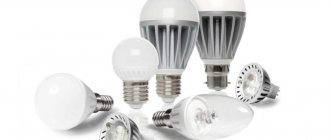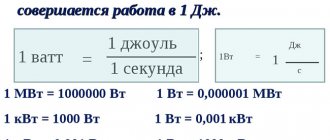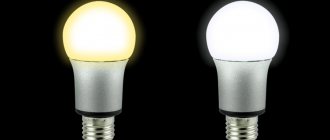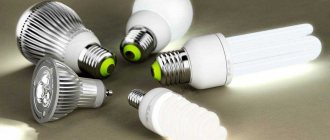Updated: 02/23/2021 12:35:17
Expert: Andrey Nikolaevich Kuznetsov
*Review of the best according to the editors of expertology.ru. About the selection criteria. This material is subjective in nature, does not constitute advertising and does not serve as a purchase guide. Before purchasing, consultation with a specialist is required.
LED lamps for home use are an excellent alternative to traditional lighting fixtures. They do not flicker, can have different color temperatures, consume minimal energy and have a long service life. But the main thing is to choose the right lamp.
Therefore, we have compiled a rating of the 12 best manufacturers of LED light bulbs, whose products are characterized by high reliability and quality.
How to choose an LED light bulb
When choosing an LED lamp, you should pay attention to the following parameters:
- Actual or equivalent power;
- Light flow;
- Colorful temperature;
- Color rendering index;
- Ripple factor.
LED lamp power
may be defined factually or equivalently. The first parameter shows how much electricity the device consumes. It can be very small - literally 6-10 watts, but this should not be confusing. Because LEDs consume minimal current. So, a 6-watt LED lamp shines as brightly as a 40-watt incandescent lamp; and a 10-watt LED is like a 60-watt incandescent.
Actually, this particular parameter can be indicated on the packaging - “equivalent to a 40 W incandescent lamp”, “equivalent to a 60 W incandescent lamp”.
Light flow
– a parameter that determines the brightness of the light bulb. More objective than actual or equivalent power. LED bulbs with a flux of 400 lumens are similar in brightness to 40-watt incandescent lamps, 600 lumens are similar to 60-watt incandescent lamps, and 1000 lumens are similar to 100-watt incandescent lamps.
Colorful temperature
– a parameter that describes whether the lamp will shine with warm or cold light. So:
- Up to 2800 K - “warm yellow”, like old incandescent lamps;
- About 3000 K - “warm white”, like modern incandescent lamps;
- About 4000 K - “neutral white”, for kitchens and office spaces;
- About 5000 K - “cool white”, for utility rooms. In the house with such a lamp it will be uncomfortable, and it causes severe strain on the eyes.
Color rendering index
– an important parameter that determines how much the light from the light bulb will affect the shades of surrounding objects. It is designated by CRI or Ra characteristics. It is recommended that the color rendering index be at least 80, and preferably 90 or higher.
With a low color rendering index, objects around you will look gray or unnaturally yellow, which affects not only your mood, but also the overall level of comfort in the room.
The pulsation coefficient shows the uniformity of the glow
. For most good LED lamps it is around 5%. If the pulsation coefficient is more than 35%, it is better not to use such a lamp - it will lead to serious eye strain.
Other characteristics do not have a special impact on operational parameters. Therefore, you don’t have to consider them - or choose LED light bulbs based on your wishes and requirements.
Quality of LED lamps now and 4 years ago
Before you read the rating, I want to inform you that at present (2019-2021) the quality of all manufacturers of LED lamps has noticeably deteriorated. Most likely this is due to an economic point of view. It is not beneficial for manufacturers that, given the popularity of LED lamps, their actual service life is 3-4 years. Some manufacturers do not install a driver at all and connect the LEDs in series; if one of them burns out, the entire lamp stops lighting. Some install a driver, but deliberately increase the output current in order to speed up the degradation of the LEDs. Still others use low-quality radiators or do not use them at all. And for LEDs, good cooling is almost mandatory!
e27 LED light source with cooling heatsink
Some buying tips:
- Do not choose e27 lamps that are too powerful, as they are more difficult to cool. It’s better to have a couple of 5-10 W lamps than one powerful 20-35 W lamp. There won't be much difference in price.
- The optimal power of filament lamps is 5-7 W. High power lamps should be purchased with a radiator. Especially filament lamps - they heat up even more
Filament light source lamp e27
- The larger the base of the LED lamp, the better. Again, for reasons of LED degradation due to their heating. Minimize the purchase of LED lamps with e14, g4, g9 ... etc. sockets.
- You should buy lamps with a warranty (2-3 years) and closer to home :)
I hope the quality of LED lamps will soon be much better.
Rating of the best manufacturers of LED light bulbs
| Nomination | place | Name of product | rating |
| The best manufacturers of LED light bulbs | 1 | Philips | 4.9 |
| 2 | Osram | 4.9 | |
| 3 | Gauss | 4.8 | |
| 4 | Feron | 4.7 | |
| 5 | Camelion | 4.6 | |
| 6 | A.S.D. | 4.5 | |
| 7 | Navigator | 4.5 | |
| 8 | Jazzway | 4.4 | |
| 9 | Era | 4.4 | |
| 10 | Space | 4.3 | |
| The best manufacturers of LED smart light bulbs | 1 | Xiaomi | 4.9 |
| 2 | Redmond | 4.8 |
So what should you buy for your home?
Give preference to models with the most neutral light that does not flicker (this can be checked using a mobile/digital camera). Do not forget that good and powerful light bulbs cannot be cheap - if the cost is too low, then the performance is likely to be exaggerated.
Differences between LED lamps and energy-saving lamps
The best manufacturers of LED light bulbs
Philips
Rating: 4.9
Why it: Proven eye safety and state-of-the-art technology.
Philips is one of the oldest manufacturers of lighting devices in general and LED lamps in particular. But its main advantage is the use of the latest technologies. Thus, the current product line includes solutions with the glow temperature switchable at the touch of a button, ultra-budget models of the Essential series for a quick and economical transition to LED devices, and even filament lamps with a transparent glass body that provide uniform angles of incidence of light.
All LED lamps developed and sold by this company have passed laboratory tests confirming their safety for vision. This is achieved not only thanks to specially set temperature parameters, but also to the almost complete absence of flicker - the pulsation coefficient, even in ultra-budget models of the Essential series, rarely exceeds 10%.
Advantages
- All lamps have passed laboratory tests showing safety of use;
- There are models with switchable color temperature;
- There are super-budget solutions.
Flaws
- High price for recessed and filament lamps;
- Narrow light dispersion angle for budget models.
What should you pay attention to when purchasing?
Base type
– must correspond to the alphanumeric marking of the cartridge.
Presence of a radiator
– on cheap lamps there is no radiator at all, which negatively affects the service life of the product.
Diffuser bulb shape
– “candle”: minimum dispersion angle (up to 100 degrees), “pear”: angle up to 150 degrees, “ball”: maximum angle (up to 360 degrees).
Price
– too low a price is a sign of a low-quality product from a dubious manufacturer.
The best manufacturers of LED smart light bulbs
Xiaomi
Rating: 4.9
Why it: Low price, compatible with proprietary smart home platform.
The main advantage of LED light bulbs from the Chinese company Xiaomi is full compatibility with the proprietary smart home platform. To configure the device, you do not need to buy additional hubs or prescribe operating algorithms. There is already a Xiaomi “head center” in the house - the light bulb will automatically connect to it.
Xiaomi Yeelight smart LED lamps are also good as lighting sources. They support more than 16 million colors thanks to RGB LED elements, adjustable color temperatures from 1500 to 6500 Kelvin (from "dim warm yellow" to "cool white"), and have a flicker rate of less than 10%.
The lamp supports communication with a smartphone and control via voice assistants Google Assistant and Yandex.Alice (via third-party plugins). You can connect other applications - for example, automate via IFTTT.
Advantages
- Full integration into the Mi Home system;
- Wide range of color temperatures and shades available;
- Expandable functionality through third-party applications.
Flaws
- Sometimes the application is unstable;
- It is difficult to find a model with the required base;
- Poorly Russified software.
Redmond
Rating: 4.8
Why it: Very low price, supports full remote control.
The Redmond smart LED light bulb is the cheapest device in its segment of the rating. At the time of writing, it can be purchased for literally a few hundred rubles! At the same time, the device supports completely remote control, as well as automatic switching on and off according to a schedule or via connection with a smartphone.
For complete remote control, the device is equipped with support for proprietary Ready for Sky technology, which connects all the company’s smart technology into a single home network with Internet access through the Gateway application.
Automatic switching on and off works in three scenarios. The first is through the application itself. The second is through the connection between the smartphone and the device: for example, when the owner comes home. The third is on schedule. Another important advantage of the device is that it is equipped with a standard E27 socket.
Advantages
- Fast and easy connection;
- Supports full remote control;
- Stable work.
Flaws
- The device itself is large;
- Plastic case.
TOP 3 LED models E27 (to replace 150 W lamps)
Such lamps are optimal for lighting rooms up to 25 square meters. m.
No3. Osram SST CLA150 20.3 W/827 E27 FR Dim
These LED ceiling lights are a great option for your home. They provide warm and cozy light without hesitation or flickering. The flask is made of frosted glass. The light beam scattering angle is 200 degrees. With a luminous flux of 2452 lm and a temperature of 2700 K, the power of the product is 21 W.
Osram SST CLA150 20.3 W/827 E27 FR Dim
pros
- you can connect a dimmer;
- The output indicators correspond to the declared ones.
Minuses
- no significant deficiencies were identified.
Prices for Osram SST CLA150 20.3 W/827 E27 FR Dim
Osram SST CLA150 20.3 W/827 E27 FR Dim
No2. Nanosvet E27 2700K
The lamp provides light that is pleasant and comfortable for the eyes without yellowness. It has a voltage of 220 V and a power of 18 W. The shape is cylindrical, the color temperature is 2700 K. The model can last 15 thousand hours.
Nanosvet E27 2700K
pros
- no flicker;
- can be used with switches that have backlighting.
Minuses
- not the lowest price.
Prices for Nanosvet E27 2700K
Nanosvet E27 2700K
No1. OSRAM LS CLA150
A pear-shaped lamp with bright warm light, an excellent option for large areas. At standard voltage, its power is 20.3 W, and the luminous flux is 2452 lm. The color temperature indicator is 2700 K. Lasts up to 15 thousand hours.
OSRAM LS CLA150
pros
- no blinking;
- the product begins to illuminate without “overclocking,” that is, immediately.
Minuses
- no serious deficiencies were found.
Prices for OSRAM LS CLA150
OSRAM LS CLA150
Selection by prices and manufacturers
Many consumers are convinced that the price tag for LED lamps from well-known manufacturers is unreasonably high and there is no point in choosing them, since there are cheaper Chinese analogues. However, everything here is far from so simple.
Expensive or cheap?
So which LED lamps are better - cheap or expensive? To answer this, you need to consider both groups separately.
Cheap lamps from China are often low-quality products. But the low price is a very tempting indicator, so Chinese LED lamps are in great demand. We list the main disadvantages of cheap Chinese LED lamps:
- the packaging contains inflated technical specifications;
- the warranty period is short or non-existent;
- low quality parts are used in the assembly;
- as a rule, the real color rendering index is less than 75 CRI;
- the driver for the LEDs is either missing or provides unstable power, thereby causing high pulsation of the light flux;
- an ineffective heat removal system is used.
You should not believe numerous positive reviews on the Internet about a cheap Chinese product and choose a product based on this criterion. Some of these reviews are simply ordered and deliberately false. And the other part was written by people who are ready to give a plus only for the fact that the goods were delivered on time or for the fact that the goods are in working condition. As a rule, there is no talk about technical characteristics and their compliance with the declared indicators.
If we consider all expensive LED lamps, then here too you can find bad products, but when choosing a more expensive product, the chance of purchasing a low-quality product is much lower.
Reliable manufacturers
Over the past years, some of the highest quality LED lamps have been produced in Europe and Japan. Their price is higher than their cheap Chinese counterparts, but the quality is at a completely different level. Below is a list of several brands that will help you choose products of decent quality.
- Philips;
- Osram;
- Wolta;
- Nichia.
Due to the influx of cheap Chinese products and the difficult financial situation in the country, most Russian manufacturers have significantly reduced the quality of their products. Today we can single out only a few Russian brands that are still trying to please consumers with their quality:
- X-Flash;
- Lisma;
- Navigator;
- Gauss.
Also on this list, a separate item worth noting is the well-proven Chinese company Camelion.
The products of the listed brands really have excellent characteristics and will serve in the home for a long time.
Comparison of lighting lamps
| Light. flow, lm | Incandescent, W | Luminescent, W | LED, W |
| 250 | 20 | 5-7 | 2-3 |
| 400 | 40 | 10-13 | 4-5 |
| 700 | 60 | 15-16 | 6-10 |
| 900 | 75 | 18-20 | 10-12 |
| 1200 | 100 | 25-30 | 12-15 |
| 1800 | 150 | 40-50 | 18-20 |
| 2500 | 200 | 60-80 | 25-30 |
You can find the most important terms in the glossary below. Manufacturers are required to indicate these values on the packaging.
TOP 5 LED lamps with E27 base (analogous to “weaving”)
The popularity of this power is explained by the fact that it makes it possible to minimally illuminate rooms up to 15 square meters. Let's take a look at the analogues of “hundreds” (100 W incandescent lamps), which are considered the best according to buyers.
No5. Bellight E27 10 W
At Leroy Merlin you can find inexpensive options, including their own production. These bulbs, made of frosted glass, have a white, cool light. The color temperature is 4000 K, the voltage is from 220 V to 230 V. The shape is pear, the luminous flux is 840 Lumens.
pros
- the price is quite affordable;
- the lights don't blink.
Minuses
- no serious deficiencies were identified.
No4. Navigator NLL-A60 6500K
This model is also pear-shaped and made of white frosted glass. Gives cool light, optimal for everyday use. When consuming 220-230 V, the device produces a luminous flux of 850 Lm. The color temperature reaches 6500 K, the light beam has an angle of 270 degrees.
pros
- saves electrical energy, and therefore money;
- work long enough (30 thousand hours).
Minuses
- no significant deficiencies were identified.
No3. Feron E27-E40 LED
The service life of these diode lamps is long - up to 30 thousand hours. They provide white, cool light that helps you concentrate on work (your eyes don't get tired). An excellent option for a spacious room, kitchen or dining room. The color flux in this case is 4700 lm, and the color temperature is 6400 K. Pear-shaped, operates on a 220-230 V network.
pros
- immediately bright light, without “overclocking”;
- there are adapters for different types of base;
- long service life;
- the light is very bright.
Minuses
- quite high cost.
No2. LED E27-E40
Powerful and bright cold glow is perfect for spacious classrooms and halls. The shape of the lamp is futuristic (pear with corners), and a good cooling system is provided. The voltage is standard, the luminous flux reaches 4700 lm. As for the color temperature, it is 6400 K.
pros
- original design;
- long service life;
- high power.
Minuses
- There is no possibility to connect a dimmer.
No1. Gauss LED 12W
According to the manufacturer, such lamps can last up to 35 years (warranty period is 3 years), which indicates the high quality of the products. The shape of the lamp is pear-shaped, with the cooling system taking up most of the structure. With a standard voltage of 220-230 W, the lamps have a power of 12 W, a luminous flux of 1220 lm and a color temperature of 2700 K. They have a height of 20 cm.
pros
- the glow is bright and warm;
- electricity is consumed economically;
- long service life.
Minuses
- no significant deficiencies were identified.
Emitter parameters
By studying the parameters of a light emitter, you can determine its capabilities and evaluate how suitable it is for use in certain conditions. Like any device powered by electricity, an LED lamp has its own characteristics. The most important ones to pay attention to include:
- Power . There are two types of it - electric and light. The first means how much energy the lamp will consume during its operation. Its unit of measurement is the watt. The second indicates the amount of luminous flux and is measured in lumens. These two values are invariably related: the brighter the light bulb shines, the more electricity it will consume. On average, to obtain 60 lumens you need to spend 1 watt of energy. The most economical options can produce a brightness of 90 Lm at 1 W.
- Temperature gradation . Defines the light spectrum. Not all types of LED lamps are suitable for home use, but only those that emit in the range from 2700 K (warm glow) to 3500 K (white light).
- Color rendering . Light sources emitting within the same temperature range can produce a variety of color perceptions. Therefore, when conducting tests of LED lamps for the home, you need to pay attention to the transmission index. The higher this coefficient, the less color distortion of illuminated objects occurs. An index of 80-1000 is considered a good indicator.
- Illumination angle . The release of energy in the crystal occurs in beams, so the light emitted by it has a directional shape. In order to illuminate a large area, diffusers are used, and the emitters are placed at different angles relative to each other. The average value of these angles is 120-270°, and the optimal value is 90-180°.
- Base . There are different standards in lighting equipment. In accordance with them, light bulbs are produced for installation in different sockets. The most used are E 14 (minion), E 27, E 40.
- Radiator type . The use of high-power LEDs requires the use of large radiators to effectively remove heat. They are made of aluminum or plastic and can be of different shapes. There are ribbed, smooth, ceramic and composite devices. Plastic has the worst thermal conductivity, while composite is optimal.
You may be interested in this Features of an infrared heating lamp
Principle of operation
LED is a semiconductor. When an electric current passes through it, it produces radiation in the visible light spectrum. Physically, it is a crystal in which a pn junction is created. When it is turned on in forward bias, when the plus of the power supply is applied to the hole zone (p), and the minus to the electron zone (n), a movement of charges occurs, which meet each other at the border of the contact zone.
When they collide, a process of recombination (mutual destruction) occurs with the release of energy. This energy forms the light perceived by the human eye. Not all semiconductors can emit in the visible spectrum. Direct-gap semiconductors are considered the best emitters. These include GaAs, InP, ZnSe, CdTe. The light bulb itself consists of several parts, which include:
- Diffuser. Used to create uniform illumination of a large area.
- Primary radiator. A heat-conducting plate in direct contact with the diode emitter.
- Main radiator. Serves to remove heat from both the diode crystal and the electronic board.
- Driver. An electronic circuit that converts the 220 volt network voltage to that required for the operation of the emitter.
- Base. Available in different sizes and designed to create reliable electrical contact.
You might be interested in Various staircase lighting systems
The electronic circuit (driver) works on the principle of frequency and voltage conversion. In addition, its main task is to maintain a given current value, while the voltage can vary.
The amount of current depends on the brightness of the LEDs, so the driver must have a power reserve of 25-30%, otherwise the current passing through it will lead to overheating of its components and failure. When reviewing and comparing LED lamps, a lot of attention is paid to the quality of this electronic module.
How we took measurements
As a tester, we used the universal Power Meter, which allows us to almost instantly obtain data on the energy consumption of any household appliance. In addition to power consumption, we also simultaneously measured the heating temperature of the light bulb body using an XL830L multimeter, because overheating is one of the most common reasons for lamp failure.
1 of 4
To eliminate the possibility of defects or accidents, we took three copies of each lamp model (8 brands in total). Each was previously operated for 500 hours. You can see the measurement results in our table.
| Model name | Light type | Analog of incandescent lamp power, W | Declared power, W | Measured power, W | Measured case temperature, °C |
| Philips | cold white | 80 | 9 | 10.4 | 65 |
| OSRAM | warm white | 75 | 9 | 9.3 | 82 |
| ERGOLUX | cold white | 80 | 10 | 10.4 | 85 |
| Navigator | cold white | 75 | 10 | 10.3 | 75 |
| Camelion | cold white | 65 | 9 | 8.3 | 72 |
| REV | warm (2700K) | 75 | 10 | 9.2 | 75 |
| ONLITE | cold white | 75 | 10 | 8.4 | 75 |
| Smartbuy | warm | 100 | 13 | 11.0 | 87 |











